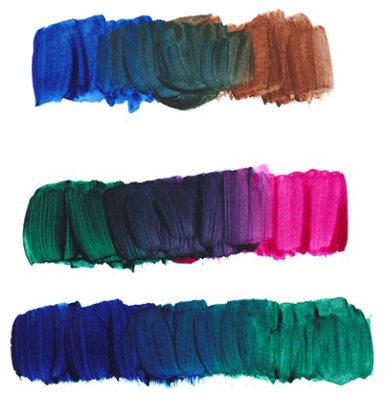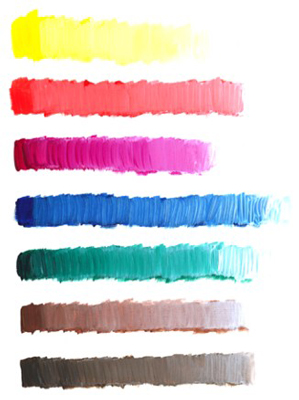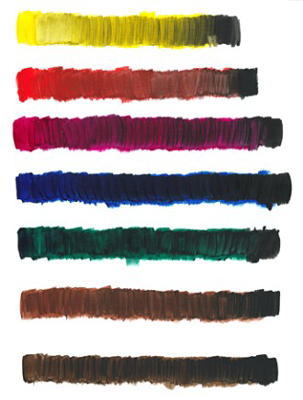Many artists prefer using acrylic paint more than oils or watercolors. Enjoy painting your first artpiece in acrylics with know how about art supplies, color mixing, and acrylic paint characteristics.
>
>
How to Get More Natural Blacks with Acrylic Paints
In an artpiece, black can be over-powering and too dark. It may look like a hole in your painting. A good alternative to using true black paint is to create a color that’s near black by mixing complementary colors (opposites on the color wheel) together, like red and green, violet and yellow, or blue and orange. This creates a color that's dark, but still adds tone and mood and consistency to your painting. Mixing dark colors together, like blue and brown or blue and green, has the same effect. Creating your own version of "black" adds more “oomph” to your art work than would using your black paint right out of the tube.

>
>
>
Checklist for Painting with Acrylics
Look over this handy list of supplies before you start an acrylic painting. Whether you're taking your first art class or painting a masterpiece at home, this checklist gets you prepared.
Brushes: You need a couple of sizes (small and larger) of each of the following:
Pointed round brush (#4, #8)
Flat (quarter inch and half inch)
Liner (#0000, #1)
Palette Knife
Paints:
White: Titanium White
Black: Mars Black
Red: Primary Magenta, Quinacridone Red or Alizarin Crimson, Cadmium Red Light
Yellow: Primary Yellow, Diarylide Yellow, Yellow Ochre
Blue: Primary Cyan, Ultramarine Blue, Phthalocyanine Blue
Orange: Pyrrole Orange or Cadmium Orange
Green: Permanent Green
Violet: Dioxazine Purple
Palette
Surface to paint
Water container and water
Paper towels
A tote bag or toolbox to carry all your supplies
>
>
>
Quick Tips for Using Acrylic Paints
Painting with acrylics is different from other mediums because of the paint's density (thickness) and acrylic drying patterns. Artists of all levels will appreciate these tips about the properties of acrylic paints.
Acrylic paints dry fast. Protect brushes from drying with paint in them by placing them in water (if you’re taking a break) or cleaning them by rinsing them in water (especially when you’re all done).
All acrylic products are compatible.
Acrylic medium makes a great glue/decoupage for adhering papers for collage.
Some acrylic paints darken as they dry.
You can clean acrylic paint off of your hands with soap and water.
You can clean dried acrylic paintings with denatured alcohol.
Acrylic paint sticks to itself, so insert a clean sheet of paper between paintings (or better yet, avoid stacking them, altogether).
Here are a few more tips about working with acrylic paints.
As you paint, keep a misting bottle of water nearby to help keep paint on your palette moist.
If you find your paint is too thick, you can thin acrylic paint with either water or acrylic medium.
Using a palette knife is usually the easiest way to mix acrylic paints.
Reusable glass and high-density plastic make good palettes because acrylic paint doesn’t cling to them, which makes cleanup easy.
>
>
>
Using a Color Wheel When Mixing Acrylic Paints
Using a color wheel will help you learn to mix acrylic paints to get the colors you want. Color mixing adds detail and excitement to your artwork.
The primary colors are yellow, red, and blue. No combination of colors can create primary colors, but primaries mix in various combinations to form all other colors. You make secondary colors (green, orange, and purple/violet) by mixing two primary colors. If you want to go farther, you can create tertiary colors by mixing one primary and one secondary color to get yellow-orange, orange-red, red-violet, violet-blue, blue-green, or yellow-green.
Keep this wheel handy to remember which colors mix to make other colors. Use the two colors on either side of the color you want to make to mix that color. Colors opposite on the wheel mix to make a gray or black. If you paint pure opposite colors next to each other, they will vibrate with energy.

>
>
>
Tinting Acrylic Paint Colors
Lightening your acrylic paint colors with white paint is called tinting. Each color has a limit on just how much lighter you can make it. This is called tinting strength. Dark colors have a higher tinting strength because they’re darker to start with and so have more room to be made lighter.
Here are the colors from the color wheel going from pure color on the left side to pure white on the right. A gradation between the two shows how many colors exist between.
You may want to tint a color in your painting for a highlight if the sun is touching it. Just add a bit of white paint to your color. Add it gradually to create a strip of paint choices that range from pure white to pure color.

>
>
>
How to Darken Acrylic Paint Colors by Shading
Adding black paint to an a lighter acrylic paint color makes it turn darker. This is called shading. Below is an assortment of colors that have been gradually darkened by adding touches of black paint. Keep in mind that black is strong; so a little paint goes a long way.
You will want to shade a color when you’re painting a shadow or fabric fold in a subject's clothing, for example. Mix a strip of paint from pure black to the pure color to provide as many choices as possible, then choose the one that looks most natural.

>
>
dummies
Source:http://www.dummies.com/how-to/content/acrylic-painting-for-dummies-cheat-sheet.html
No comments:
Post a Comment